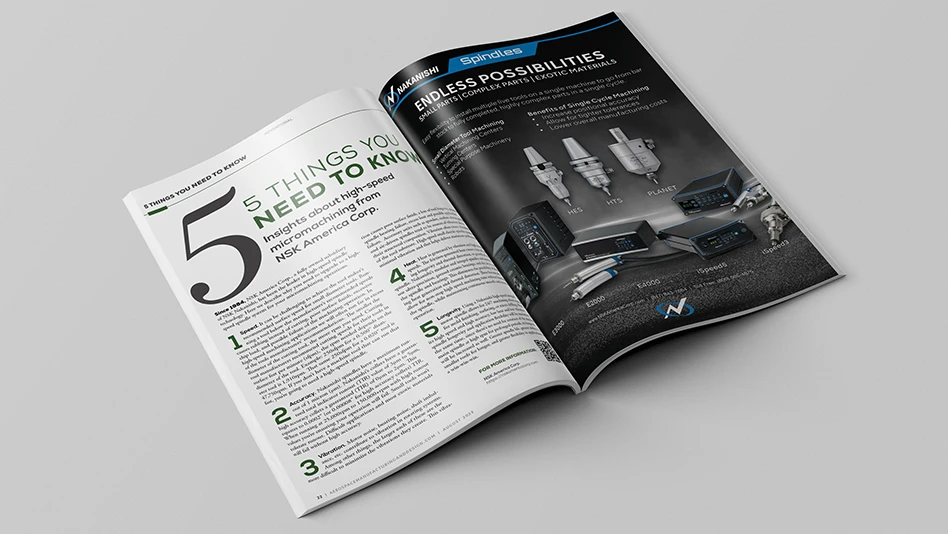
Since 1984, NSK America Corp., a fully owned subsidiary of NSK Nakanishi, has been the leader in high-speed spindle technology. Here we describe why you need to upgrade to a high-speed spindle system for your micromachining operations.
1. Speed.
It can be challenging to achieve the tool maker’s recommended surface speed for small diameter tools. Running a tool below the manufacturer’s recommended speeds causes rubbing instead of cutting, poor surface finish, excessive chip load, and possible failure of the machining operation. In high-speed machining applications we will often run far in excess of the tools manufacturers’ recommendations. The smaller the diameter of the cutting tool, the more rpm you need. Cutting tool manufacturers recommend cutting speeds for their tools in surface feet per minute (sfpm), the rpm needed depends on the diameter of the tool. Example: 250sfpm for a 0.500" diameter tool is 1,910rpm. That same 250sfpm for a 0.020" tool is 47,750rpm. If you don’t have a machine tool that can run that fast, you’re going to need a high-speed spindle.
2. Accuracy.
Nakanishi spindles have a maximum run-out of 1 micron (µm). Nakanishi’s collets have a guaranteed total indicator runout (TIR) value of 3µm to 5µm, high accuracy collets a guaranteed (TIR) of 0µm to 2µm. This equates to 0.0002" (or 0.00008" for high accuracy collets) TIR. When running at 25,000rpm to 150,000+rpm with high runout values you’re ensuring your operation will fail. Small tools won’t tolerate runout. Difficult applications and most exotic materials will fail without high accuracy.
3. Vibration.
Motor noise, bearing noise, shaft imbalance, etc. contribute to vibration in rotating systems. Among other things, the larger each of these are the more difficult to minimize the vibrations they create. This vibration causes poor surface finish, a loss of tool longevity, premature spindle bearing failure, excess heat and possible application failure. Accessory units such as speeders, coolant-driven spindles, and air-driven spindles tend to be sources of vibration due to their structural composition. Vibration often causes a breakdown of the tool substrate. High-speed small electric spindles produce minimal vibration and that helps deliver maximum performance.
4. Heat.
Heat is generated by vibration and high rotation speeds. The friction-generated heat causes a loss of bearing longevity and thermal distortion, or growth of the spindle. Nakanishi’s modular and integral spindles and motors use ultra-precision, greased ceramic bearings, and dry air to cool the spindle and bearings. This eliminates the possibility of allowing heat generation and thermal distortion. These features also allow for non-stop high speed machining time without harming the spindle, while maintaining continuous smooth and accurate operation.
5. Longevity.
Using a Nakanishi high-speed integral motor spindle allows for 24/7 machining often required for mold finishing, surfacing, or micro drilling. With its high speed and high accuracy, low heat and low vibration, spindle longevity and application flexibility will be maximized. At the same time, since there’s no need for rotation of the machine’s main spindle at high rpm for prolonged periods, its longevity will be increased as well. Greater spindle life, greater ability to use smaller tools for longer, and greater flexibility in applications; It’s a win-win-win.


Explore the August 2023 Issue
Check out more from this issue and find your next story to read.
Latest from Aerospace Manufacturing and Design
- How to Reduce First Article Inspection Creation Time by 70% to 90% with DISCUS Software
- Jackson Square Aviation orders 50 Airbus A320neo aircraft
- Beckhoff's motion control automation solutions
- #40 - Lunch & Learn with Fagor Automation
- Air Methods to purchase up to 28 Bell helicopters
- AMADA's laser marking capabilities
- magniX launches engine line for electric helicopters
- Creaform's Creaform.OS, Creaform Metrology Suite







